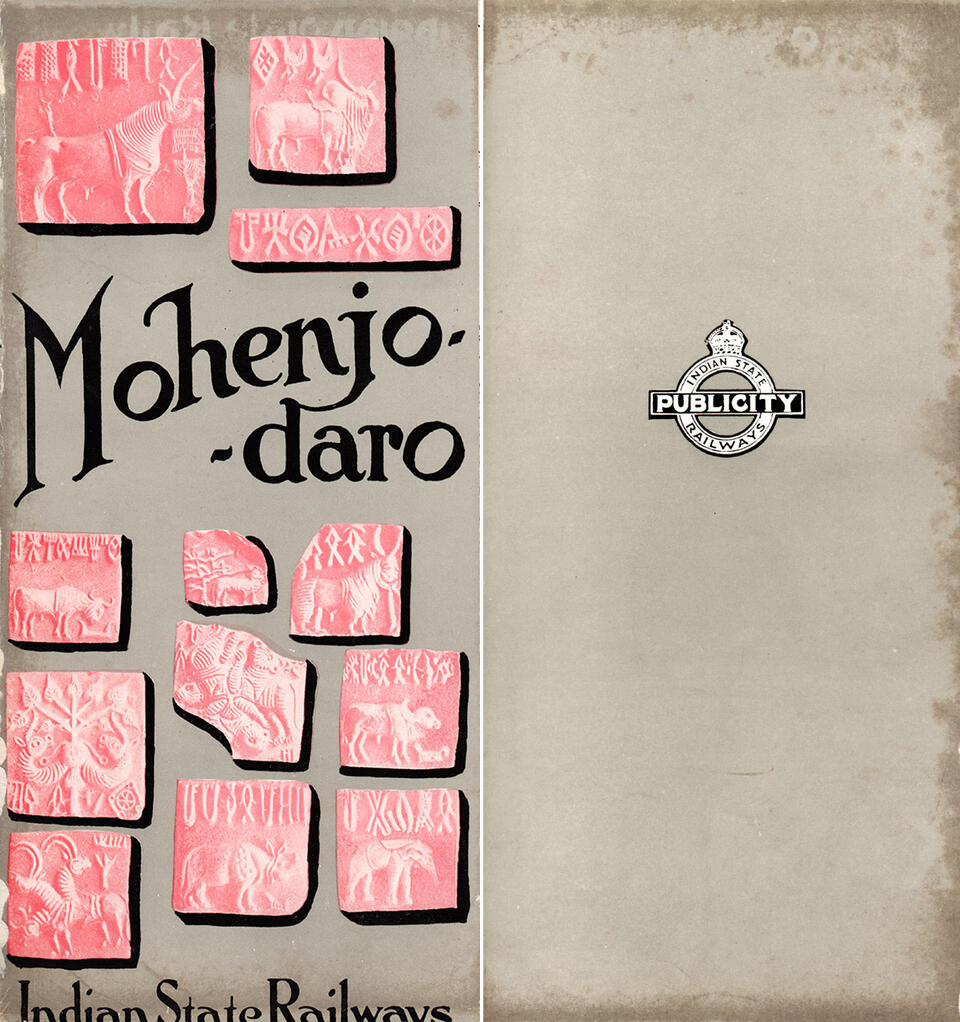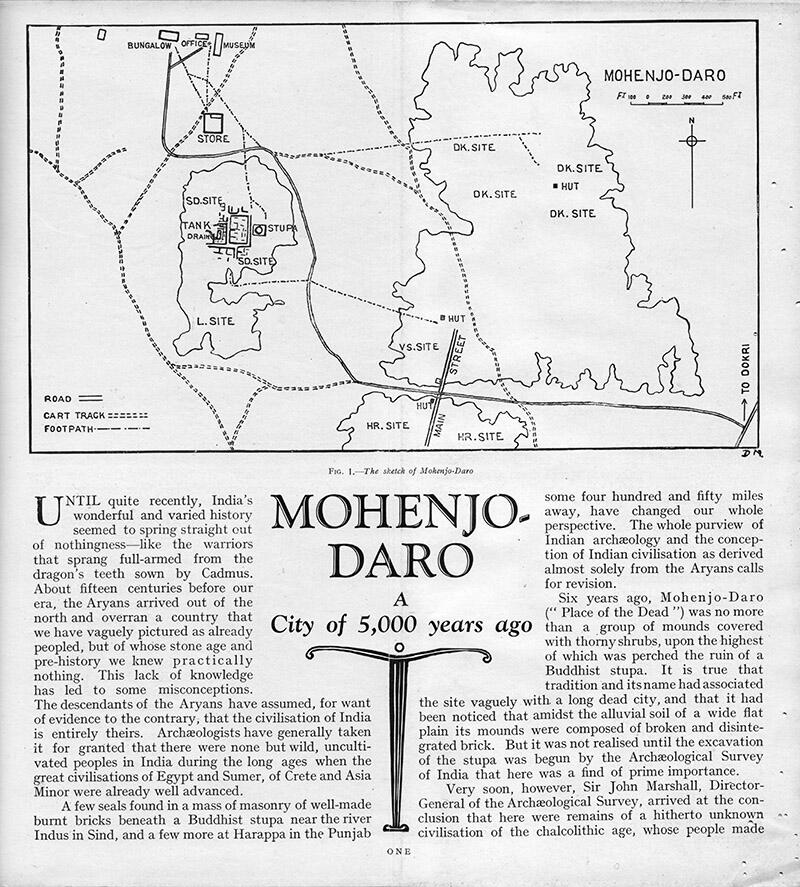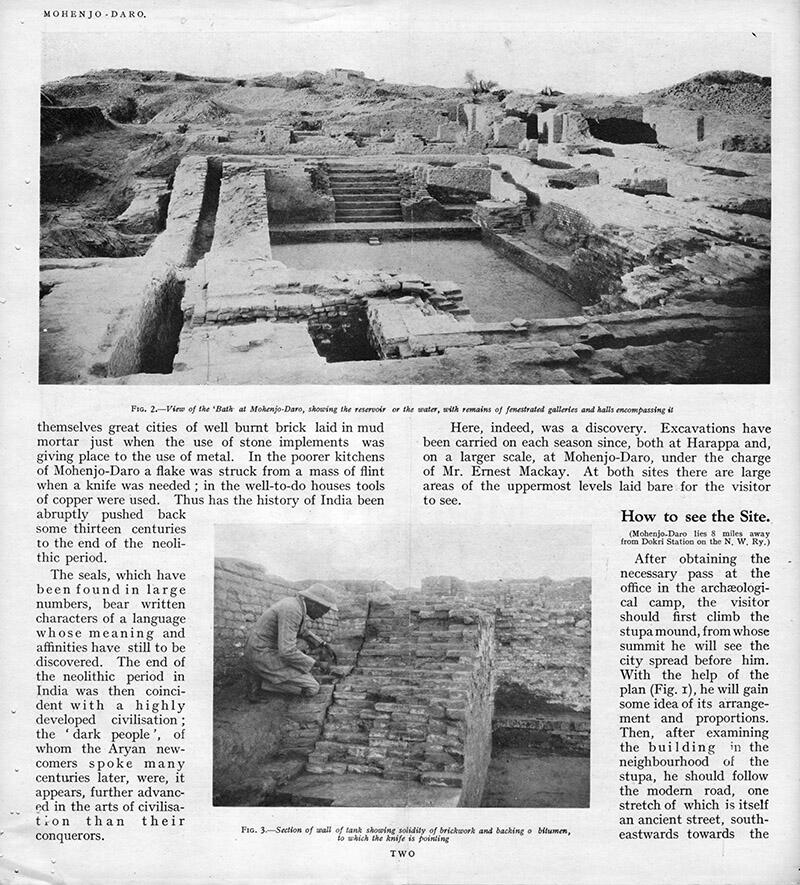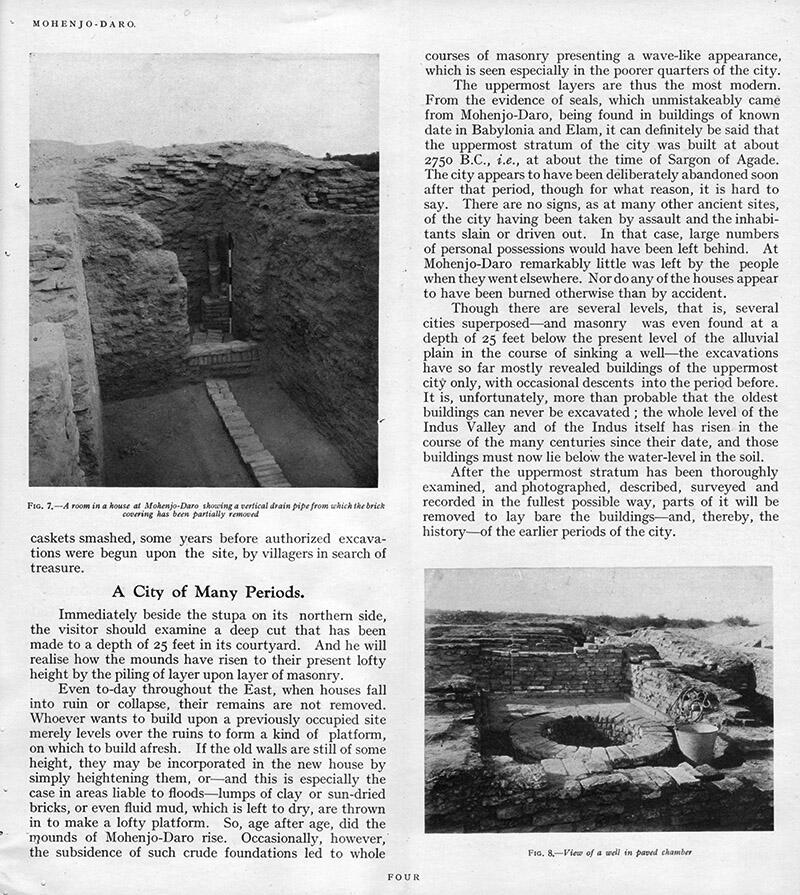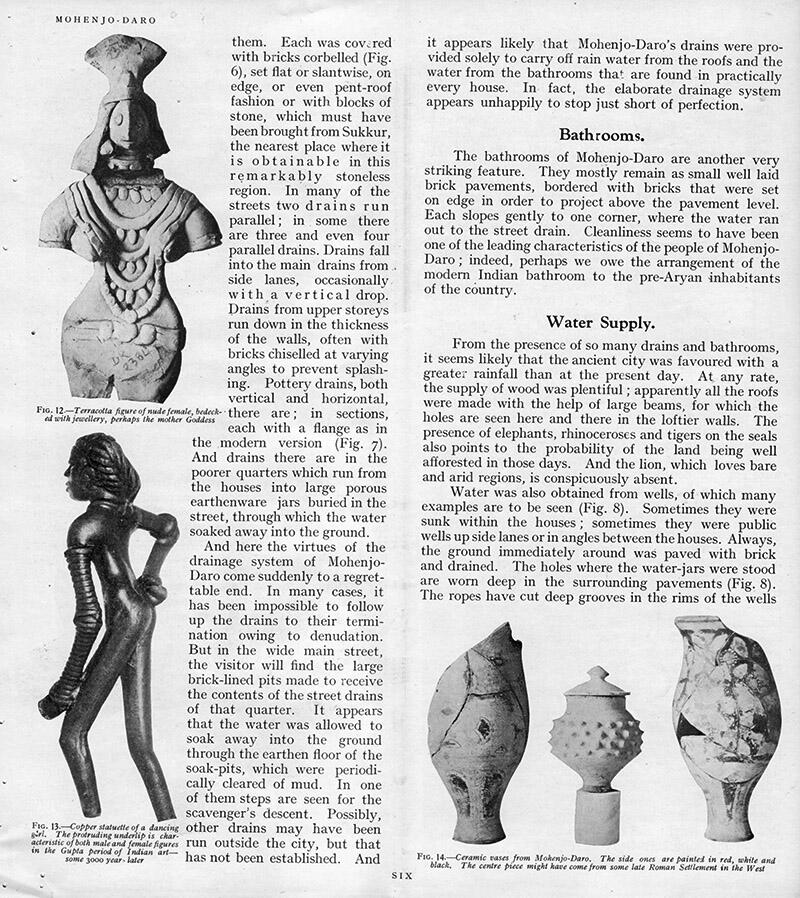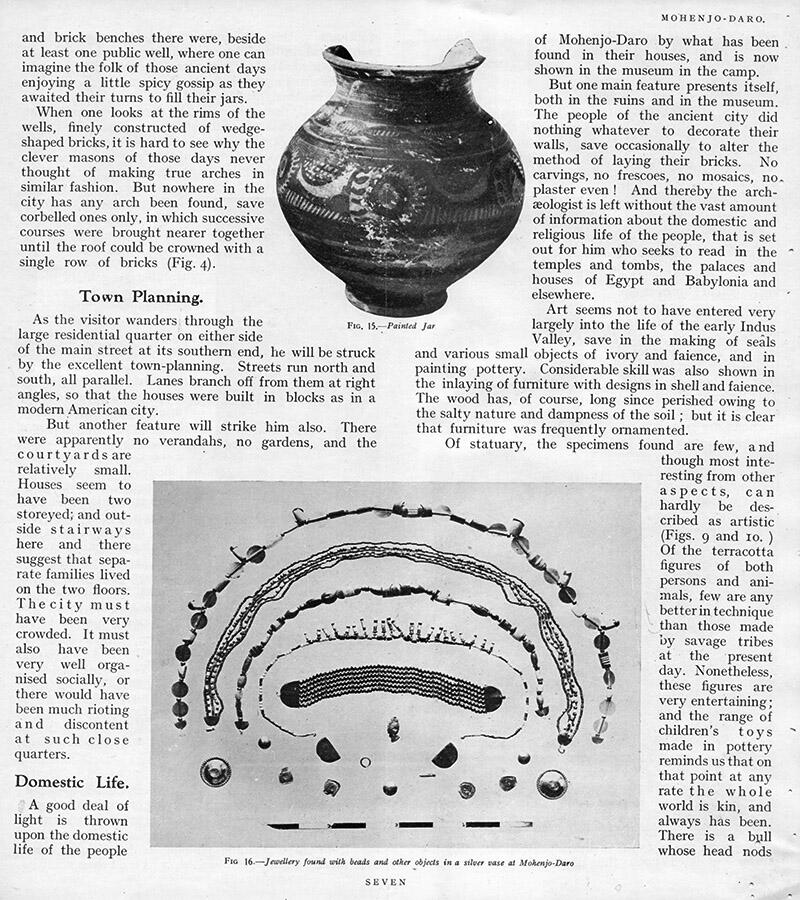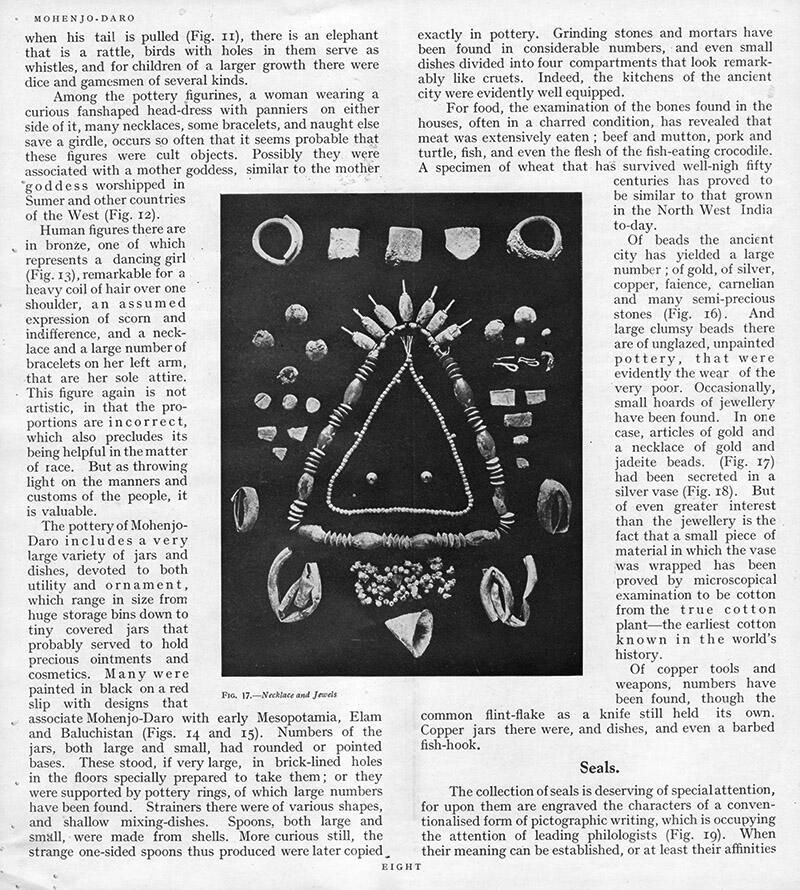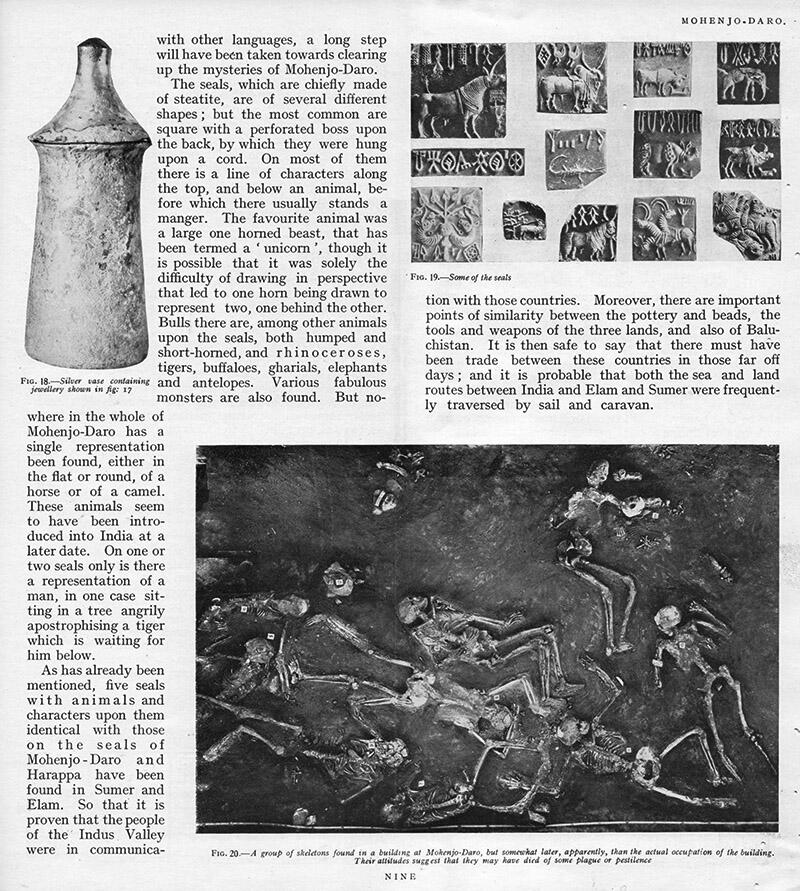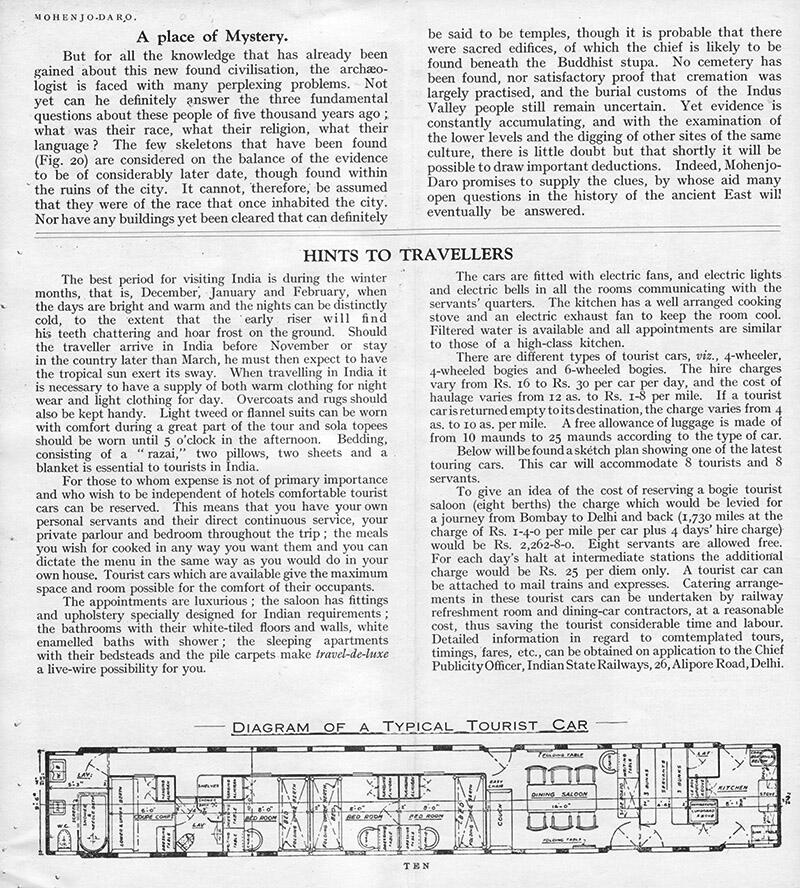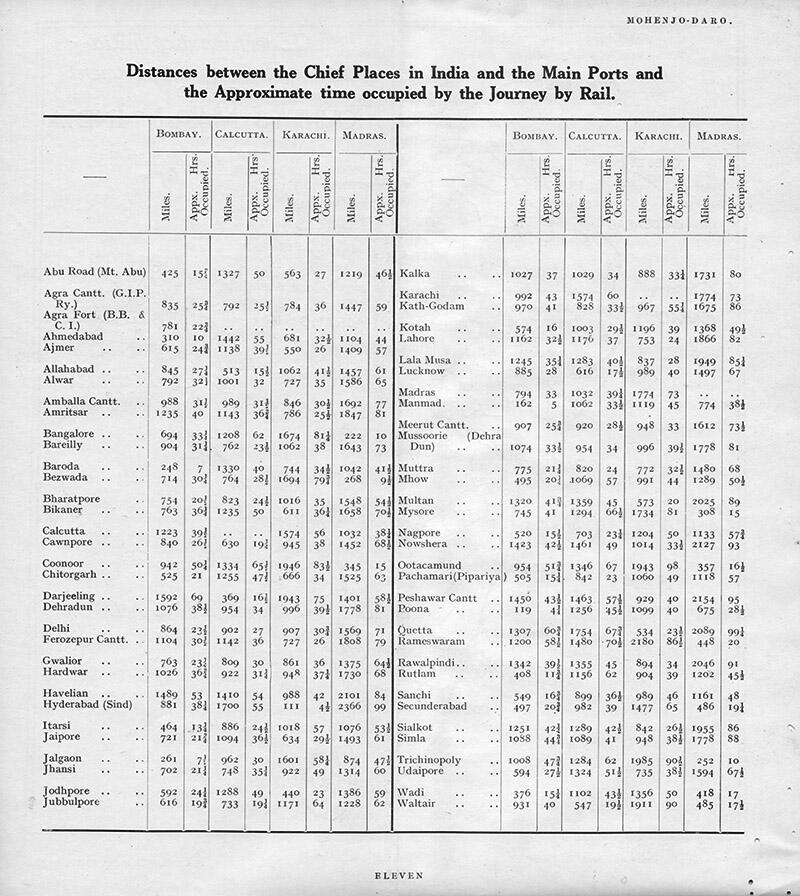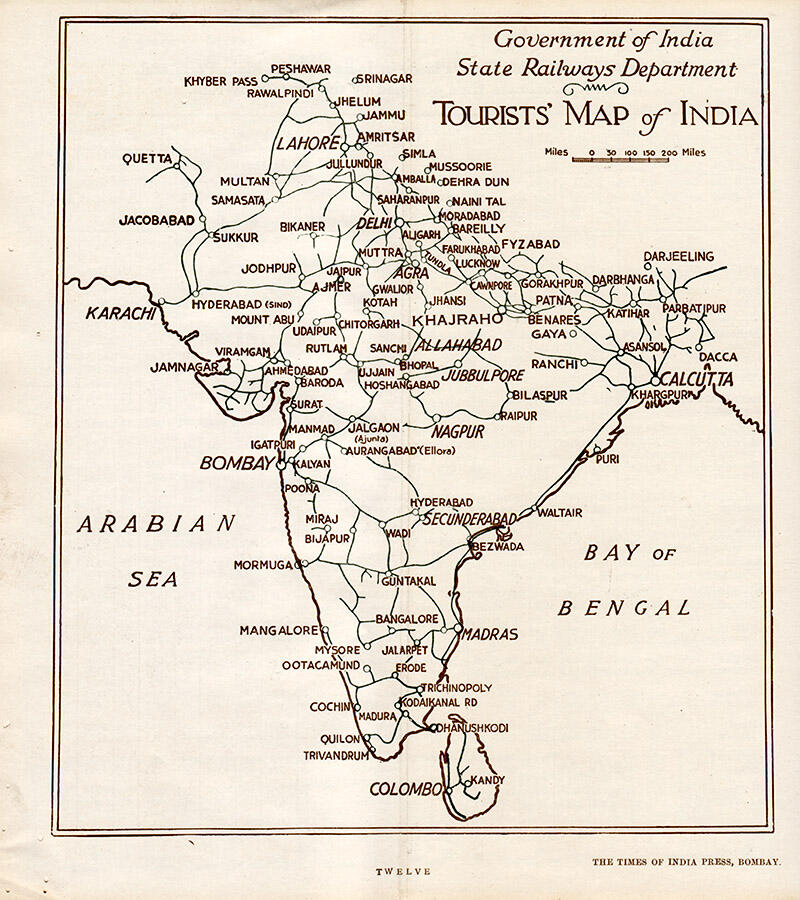June 29th, 2021
An Indian State Railways brochure advertising Mohenjo-daro from approximately 1935. Below is the full text of the brochure (figures, captions and charts are in the images above).
MOHENJO-DARO A City of 5,000 years ago
Until quite recently, India's wonderful and varied history seemed to spring straight out of nothingness—like the warriors that sprang full-armed from the dragon's teeth sown by Cadmus. About fifteen centuries before our era, the Aryans arrived out of the north and overran a country that we have vaguely pictured as already peopled, but of whose stone age and pre-history we knew practically nothing. This lack of knowledge has led to some misconceptions. The descendants of the Aryans have assumed, for want of evidence to the contrary, that the civilisation of India is entirely theirs. Archaeologists have generally taken it for granted that there were none but wild, uncultivated peoples in India during the long ages when the great civilisations of Egypt and Sumer, of Crete and Asia Minor were already well advanced.
A few seals found in a mass of masonry of well-made burnt bricks beneath a Buddhist stupa near the river Indus in Sind, and a few more at Harappa in the Punjab some four hundred and fifty miles away, have changed our whole perspective. The whole purview of Indian archaeology and the conception of Indian civilisation as derived almost solely from the Aryans calls for revision.
Six years ago, Mohenjo-Daro (“Place of the Dead") was no more than a group of mounds covered with thorny shrubs, upon the highest of which was perched the ruin of a Buddhist stupa. It is true that tradition and its name had associated the site vaguely with, a long dead city, and that it had been noticed that amidst the alluvial soil of a wide flat plain its mounds were composed of broken and disintegrated brick. But it was not realised until the excavation of the stupa was begun by the Archaeological Survey of India that here was a find of prime importance.
Very soon, however, Sir John Marshall, Director-General of the Archaeological Survey, arrived at the conclusion that here were remains of a hitherto unknown civilisation of the chalcolithic age, whose people made themselves great cities of well burnt brick laid in mud mortar just when the use of stone implements was giving place to the use of metal. In the poorer kitchens of Mohenjo-Daro a flake was struck from a mass of flint when a knife was needed ; in the well-to-do houses tools of copper were used. Thus has the history of India been abruptly pushed back some thirteen centuries to the end of the neolithic period.
The seals, which have been found in large numbers, bear written characters of a language whose meaning and affinities have still to be discovered. The end of the neolithic period in India was then coincident with a highly developed civilisation; the ‘dark people' of whom the Aryan newcomers spoke many centuries later, were, it appears, further advanced in the arts of civilisation than their conquerors.
Here, indeed, was a discovery. Excavations have been carried on each season since, both at Harappa and, on a larger scale, at Mohenjo-Daro, under the charge of Mr. Ernest Mackay. At both sites there are large areas of the uppermost levels laid bare for the visitor to see.
How to see the Site.
(Mohenjo-Daro lies 8 miles away from Dokri Station on the N. W. Ry.)
After obtaining the necessary pass at the office in the archaeological camp, the visitor should first climb the stupa mound, from whose summit he will see the city spread before him. With the help of the plan (Fig. iI, he will gain some idea of its arrangement and proportions. Then, after examining the building in the neighbourhood of the stupa, he should follow the modem road, one stretch of which is itself an ancient street, south-eastwards towards the broad main street of the ancient city, which runs at right angles to it. Here, residential and bazaar quarters lie to right and left.
If, in his general survey of the city, the visitor be puzzled at the apparent absence of city walls, he should remember that burnt bricks have ever been prized by whomsoever would build himself a house, and that the outer wall is the first part of the city to be reached by the brick robber. Ample .evidence there is that Mohenjo-Daro has proved a veritable ‘brick mine' for its neighbours throughout the ages. In fact, right at his feet the visitor will see how the Buddhist monks of the second century A.D. themselves used the bricks of the old city to build the lower part of their stupa and its monastery. Their masonry is, incidentally, remarkably amateurish as compared with that of the masons of the chalcolithic age, some thirty centuries before.
The Buddhist Stupa.
Of the stupa itself but little remains. Nor is there any evidence that it was ever comparable in beauty of decoration and proportion with the Buddhist stupas of Sanchi, Taxila, and elsewhere in India. Coins found in the cells of the monks suggest that it was occupied by the Kushan king Vasudeva (140-173 A.D.). The drum which was constructed of sun-dried mudbrick once contained a relic of Buddha, or of one of his saints, in an alabaster casket; but the building was excavated and the caskets smashed, some years before authorized excavations were begun upon the site, by villagers in search of treasure.
A City of Many Periods.
Immediately beside the stupa on its northern side, the visitor should examine a deep cut that has been made to a depth of 25 feet in its courtyard. And he will realise how the mounds have risen to their present lofty height by the piling of layer upon layer of masonry.
Even to-day throughout the East, when houses fall into ruin or collapse, their remains are not removed. Whoever wants to build upon a previously occupied site merely levels over the ruins to form a kind of platform, on which to build afresh. If the old walls are still of some height, they may be incorporated in the new house by simply heightening them, or—and this is especially the case in areas liable to floods—lumps of clay or sun-dried bricks, or even fluid mud, which is left to dry, are thrown in to make a lofty platform. So, age after age, did the mounds of Mohenjo-Daro rise. Occasionally, however, the subsidence of such crude foundations led to whole courses of masonry presenting a wave-like appearance, which is seen especially in the poorer quarters of the city.
The uppermost layers are thus the most modem. From the evidence of seals, which unmistakeably came from Mohenjo-Daro, being found in buildings of known date in Babylonia and Elam, it can definitely be said that the uppermost stratum of the city was built at about 2750 B.C., i.e.t at about the time of Sargon of Agade. The city appears to have been deliberately abandoned soon after that period, though for what reason, it is hard to say. There are no signs, as at many other ancient sites, of the city having been taken by assault and the inhabitants slain or driven out. In that case, large numbers of personal possessions would have been left behind. At Mohenjo-Daro remarkably little was left by the people when they went elsewhere. Nor do any of the houses appear to have been burned otherwise than by accident.
Though there are several levels, that is, several cities superposed—and masonry was even found at a depth of 25 feet below the present level of the alluvial plain in the course of sinking a well—the excavations have so far mostly revealed buildings of the uppermost city only, with occasional descents into the period before. It is, unfortunately, more than probable that the oldest buildings can never be excavated ; the whole level of the Indus Valley and of the Indus itself has risen in the course of the many centuries since their date, and those buildings must now lie below the water-level in the soil.
After the uppermost stratum has been thoroughly examined, and photographed, described, surveyed and recorded in the fullest possible way, parts of it will be removed to lay bare the buildings—and, thereby, the history—of the earlier periods of the city.
The Great Tank.
To the west of the stupa mound, the visitor looks down upon what was perhaps the priestly quarter, of which the most noticeable feature is the Great Tank (Fig. 2), which belongs to the penultimate period of the city. This tank is 39 feet long by 23 feet wide, and occupies the centre of a massive building, which has been much denuded both by the brick robber and the hand of time. But enough remains for us to see that the rectangular tank was once surrounded by a platform, supported on cross-walls, the spaces between filled up with sun-dried mud-brick. This platform was backed by cloisters on all four sides, and the whole building enclosed in massive walls, to which additional strength was given by a slight inward slope, or batter, of the outer face.
The tank was very carefully built; in fact, its walls were even rubbed down to give them extra smoothness, and the floor is well and closely laid with bricks set on edge. Indeed, the excellence of the masonry, for which gypsum mortar was employed, is quite remarkable ; it far exceeds in quality the masonry of the later period. Two broad flights of steps lead down into the tank at its northern and southern ends ; and the ends of these steps recessed to take wooden, or possibly wood and metal, treads should be noted. Before leaving the tank, the visitors should also note the damp-proof course of bitumen (Fig. 3), of which traces can still be seen in the eastern wall—an elaboration that one would hardly expect in a building of five thousand years ago.
The floor slopes gradually to the south-western corner, where a small aperture leads into a large drain, which is one of the most striking architectural features of the city. The first section in which a tall man could have stood upright, was evidently roofed over with beams, for which the holes still remain. The floor, in which there is a central channel, is also carefully laid with bricks set on edge. At the further end of this drainage chamber, a manhole in the roof gave access to it for periodical cleaning. Beyond that, the drain diminishes somewhat in height and narrows into a curved passage with a remarkable corbelled roof (Fig. 4).
How the tank was filled is still uncertain, as there is no apparent connection between it and the large well in one of the eastern rooms of the same building, which might be assumed to have been used for the purpose. The actual purpose of the tank is also a matter of surmise.
It may have been used, as are so many tanks in India to-day, for sacred fish or crocodiles. But in view of the marked predilection of the people of the city for cleanliness, as shown by their many bathrooms, it is more likely that the Great Tank was used for bathing—possibly in connection with the ritual of their religion.
To the north of the building containing the tank, there are houses of the latest period, which may have been priestly or ordinary residential quarters. And they are capped at their northernmost end by a second group of monastic buildings constructed by the Buddhist monks.
Drainage of the Ancient City.
The Great Tank is separated from the stupa by a block of buildings between two parallel streets. And houses of much the same type cover the southern slope of the stupa mound, separated into blocks by narrow lanes. Here there are good examples of the drains, which may— rather absurdly—be said to be Mohenjo-Daro’s crowning glory! Under every street and lane of the well planned city they ran, receiving small tributaries from the houses on either side (Fig. 5). And the streets and lanes have been systematically excavated to below their original level in order to show them. Each was covered with bricks corbelled (Fig. 6), set flat or slantwise, on edge, or even pent-roof fashion or with blocks of stone, which must have been brought from Sukkur, the nearest place where it is obtainable in this remarkably stoneless region. In many of the streets two drains run parallel; in some there are three and even four parallel drains. Drains fall into the main drains from side lanes, occasionally with a vertical drop. Drains from upper storeys run down in the thickness of the walls, often with bricks chiselled at varying angles to prevent splashing. Pottery drains, both vertical and horizontal, each with a flange as m the modern version (Fig. 7). And drains there are in the poorer quarters which run from the houses into large porous earthenware jars buried in the street, through which the water soaked away into the ground.
And here the virtues of the drainage system of Mohenjo-Daro come suddenly to a regrettable end. In many cases, it has been impossible to follow up the drains to their termination owing to denudation. But in the wide main street, the visitor will find the large brick-lined pits made to receive the contents of the street drains of that quarter. It appears that the water was allowed to soak away into the ground through the earthen floor of the soak-pits, which were periodically cleared of mud. In one of them steps are seen for the scavenger’s descent. Possibly, other drains may have been run outside the city, but that has not been established. And it appears likely that Mohenjo-Daro’s drains were provided solely to carry off rain water from the roofs and the water from the bathrooms that are found in practically every house. In fact, the elaborate drainage system appears unhappily to stop just short of perfection.
Bathrooms.
The bathrooms of Mohenjo-Daro are another very striking feature. They mostly remain as small well laid brick pavements, bordered with bricks that were set on edge in order to project above the pavement level. Each slopes gently to one comer, where the water ran out to the street drain. Cleanliness seems to have been one of the leading characteristics of the people of Mohenjo-Daro ; indeed, perhaps we owe the arrangement of the modern Indian bathroom to the pre-Aryan inhabitants of the country.
Water Supply
From the presence of so many drains and bathrooms, it seems likely that the ancient city was favoured with a greater rainfall than at the present day. At any rate, the supply of wood was plentiful; apparently all the roofs were made with the help of large beams, for which the holes are seen here and there in the loftier walls. The presence of elephants, rhinoceroses and tigers on the seals also points to the probability of the land being well afforested in those days. And the lion, which loves bare and arid regions, is conspicuously absent.
Water was also obtained from wells, of which many examples are to be seen (Fig. 8). Sometimes they were sunk within the houses ; sometimes they were public wells up side lanes or in angles between the houses. Always, the ground immediately around was paved with brick and drained. The holes where the water-jars were stood are worn deep in the surrounding pavements (Fig. 8). The ropes have cut deep grooves in the rims of the wells and brick benches there were, beside at least one public well, where one can imagine the folk of those ancient days enjoying a little spicy gossip as they awaited their turns to fill their jars.
When one looks at the rims of the wells, finely constructed of wedge-shaped bricks, it is hard to see why the clever masons of those days never thought of making true arches in similar fashion. But nowhere in the city has any arch been found, save corbelled ones only, in which successive courses were brought nearer together until the roof could be crowned with a single row of bricks (Fig. 4).
Town Planning
As the visitor wanders through the large residential quarter on either side of the main street at its southern end, he will be struck by the excellent town-planning. Streets run north and south, all parallel. Lanes branch off from them at right angles, so that the houses were built in blocks as in a modem American city.
But another feature will strike him also. There were apparently no verandahs, no gardens, and the courtyards are relatively small. Houses seem to have been two storeyed; and outside stairways here and there suggest that separate families lived on the two floors. The city must have been very crowded. It must also have been very well organised socially, or there would have been much rioting and discontent at such close quarters.
Domestic Life.
A good deal of light is thrown upon the domestic life of the people of Mohenjo-Daro by what has been found in their houses, and is now shown in the museum in the camp.
But one main feature presents itself, both in the ruins and in the museum. The people of the ancient city did nothing whatever to decorate their walls, save occasionally to alter the method of laying their bricks. No carvings, no frescoes, no mosaics, no. plaster even ! And thereby the archaeologist is left without the vast amount of information about the domestic and religious life of the people, that is set out for him who seeks to read in the temples and tombs, the palaces and houses of Egypt and Babylonia and elsewhere.
Art seems not to have entered very largely into the life of the early Indus Valley, save in the making of seals and various small objects of ivory and faience, and in painting pottery. Considerable skill was also shown in the inlaying of furniture with designs in shell and faience. The wood has, of course, long since perished owing to the salty nature and dampness of the soil; but it is clear that furniture was frequently ornamented.
Of statuary, the specimens found are few, and though most interesting from other aspects, can hardly be described as artistic (Figs. 9 and 10.) Of the terracotta figures of both persons and animals, few are any better in technique than those made by savage tribes at the present day. Nonetheless, these figures are very entertaining; and the range of children’s toys made in pottery reminds us that on that point at any rate the whole world is kin, and always has been. There is a bull whose head nods when his tail is pulled (Fig. 11), there is an elephant that is a rattle, birds with holes in them serve as whistles, and for children of a larger growth there were dice and gamesmen of several kinds.
Among the pottery figurines, a woman wearing a curious fanshaped head-dress with panniers on either side of it, many necklaces, some bracelets, and naught else save a girdle, occurs so often that it seems probable that these figures were cult objects. Possibly they were associated with a mother goddess, similar to the mother goddess worshipped in Sumer and other countries of the West (Fig. 12).
Human figures there are in bronze, one of which represents a dancing girl (Fig. 13), remarkable for a heavy coil of hair over one shoulder, an assumed expression of scorn and indifference, and a necklace and a large number of bracelets on her left arm, that are her sole attire. This figure again is not artistic, in that the proportions are incorrect, which also precludes its being helpful in the matter of race. But as throwing light on the manners and customs of the people, it is valuable.
The pottery of Mohenjo-Daro includes a very large variety of jars and dishes, devoted to both utility and ornament, which range in size from huge storage bins down to tiny covered jars that probably served to hold precious ointments and cosmetics. Many were painted in black on a red slip with designs that associate Mohenjo-Daro with early Mesopotamia, Elam and Baluchistan (Figs. 14 and 15). Numbers of the jars, both large and small, had rounded or pointed bases. These stood, if very large, in brick-lined holes in the floors specially prepared to take them; or they were supported by pottery rings, of which large numbers have been found. Strainers there were of various shapes, and shallow mixing-dishes. Spoons, both large and small, were made from shells. More curious still, the strange one-sided spoons thus produced were later copied exactly in pottery. Grinding stones and mortars have been found in considerable numbers, and even small dishes divided into four compartments that look remarkably like cruets. Indeed, the kitchens of the ancient city were evidently well equipped.
For food, the examination of the bones found in the houses, often in a charred condition, has revealed that meat was extensively eaten ; beef and mutton, pork and turtle, fish, and even the flesh of the fish-eating crocodile. A specimen of wheat that has survived well-nigh fifty
centuries has proved to be similar to that grown in the North West India to-day.
Of beads the ancient city has yielded a large number ; of gold, of silver, copper, faience, carnelian and many semi-precious stones (Fig. 16). And large clumsy beads there are of unglazed, unpainted pottery, that were evidently the wear of the very poor. Occasionally, small hoards of jewellery have been found. In one case, articles of gold and a necklace of gold and jadeite beads. (Fig. 17) had been secreted in a silver vase (Fig. 18). But of even greater interest than the jewellery is the fact that a small piece of material in which the vase was wrapped has been proved by microscopical examination to be cotton from the true cotton plant—the earliest cotton known in the world's history.
Of copper tools and weapons, numbers have been found, though the common flint-flake as a knife still held its own. Copper jars there were, and dishes, and even a barbed fish-hook.
Seals.
The collection of seals is deserving of special attention, for upon them are engraved the characters of a conventionalised form of pictographic writing, which is occupying the attention of leading philologists (Fig. 19). When their meaning can be established, or at least their affinities
with other languages, a long step will have been taken towards clearing up the mysteries of Mohenjo-Daro.
The seals, which are chiefly made of steatite, are of several different shapes ; but the most common are square with a perforated boss upon the back, by which they were hung upon a cord. On most of them there is a line of characters along the top, and below an animal, before which there usually stands a manger. The favourite animal was a large one homed beast, that has been termed a * unicorn ', though it is possible that it was solely the difficulty of drawing in perspective that led to one horn being drawn to represent two, one behind the other.
Bulls there are, among other animals upon the seals, both humped and short-homed, and rhinoceroses, tigers, buffaloes, gharials, elephants and antelopes. Various fabulous monsters are also found. But nowhere in the whole of Mohenjo-Daro has a single representation been found, either in the flat or round, of a horse or of a camel. These animals seem to have been introduced into India at a later date. On one or two seals only is there a representation of a man, in one case sitting in a tree angrily apostrophising a tiger which is waiting for him below.
As has already been mentioned, five seals with animals and characters upon them identical with those on the seals of Mohenjo-Daro and Harappa have been found in Sumer and Elam. So that it is proven that the people of the Indus Valley were in communication with those countries. Moreover, there are important points of similarity between the pottery and beads, the tools and weapons of the three lands, and also of Baluchistan. It is then safe to say that there must have been trade between these countries in those far off days ; and it is probable that both the sea and land routes between India and Elam and Sumer were frequently traversed by sail and caravan.
A place of Mystery.
But for all the knowledge that has already been gained about this new found civilisation, the archaeologist is faced with many perplexing problems. Not yet can he definitely answer the three fundamental questions about these people of five thousand years ago ; what was their race, what their religion, what their language ? The few skeletons that have been found (Fig. 20) are considered on the balance of the evidence to be of considerably later date, though found within the ruins of the city. It cannot, therefore, be assumed that they were of the race that once inhabited the city. Nor have any buildings yet been cleared that can definitely be said to be temples, though it is probable that there were sacred edifices, of which the chief is likely to be found beneath the Buddhist stupa. No cemetery has been found, nor satisfactory proof that cremation was largely practised, and the burial customs of the Indus Valley people still remain uncertain. Yet evidence is constantly accumulating, and with the examination of the lower levels and the digging of other sites of the same culture, there is little doubt but that shortly it will be possible to draw important deductions. Indeed, Mohenjo-Daro promises to supply the clues, by whose aid many open questions in the history of the ancient East will eventually be answered.
HINTS TO TRAVELLERS.
The best period for visiting India is during the winter months, that is, December, January and February, when the days are bright and warm and the nights can be distinctly cold, to the extent that the early riser will fi n d his teeth chattering and hoar frost on the ground. Should the traveller arrive in India before November or stay in the country later than March, he must then expect to have the tropical sun exert its sway. When travelling in India it is necessary to have a supply of both warm clothing for night wear and light clothing for day. Overcoats and rugs should also be kept handy. Light tweed or flannel suits can be worn with comfort during a great part of the tour and sola topees should be worn until 5 o’clock in the afternoon. Bedding, consisting of a “razai,” two pillows, two sheets and a blanket is essential to tourists in India.
For those to whom expense is not of primary importance and who wish to be independent of hotels comfortable tourist cars can be reserved. This means that you have your own personal servants and their direct continuous service, your private parlour and bedroom throughout the trip; the meals you wish for cooked in any way you want them and you can dictate the menu in the same way as you would do in your own house. Tourist cars which are available give the maximum space and room possible for the comfort of their occupants.
The appointments are luxurious ; the saloon has fittings and upholstery specially designed for Indian requirements ; the bathrooms with their white-tiled floors and walls, white enamelled baths with shower; the sleeping apartments with their bedsteads and the pile carpets make travel-de-luxe a live-wire possibility for you.
The cars are fitted with electric fans, and electric lights and electric bells in all the rooms communicating with the servants’ quarters. The kitchen has a well arranged cooking stove and an electric exhaust fan to keep the room cool. Filtered water is available and all appointments are similar to those of a high-class kitchen.
There are different types of tourist cars, viz., 4-wheeler, 4-wheeled bogies and 6-wheeled bogies. The hire charges vary from Rs. 16 to Rs. 30 per car per day, and the cost of haulage varies from 12 as. to Rs. 1-8 per mile. If a tourist car is returned empty to its destination, the charge varies from 4 as. to 10 as. per mile. A free allowance of luggage is made of from 10 maunds to 25 maunds according to the type of car.
Below will be found a sketch plan showing one of the latest touring cars. This car will accommodate 8 tourists and 8 servants.
To give an idea of the cost of reserving a bogie tourist saloon (eight berths) the charge which would be levied for a journey from Bombay to Delhi and back (1,730 miles at the charge of Rs. 1-4-0 per mile per car plus 4 days’ hire charge) would be Rs. 2,262-8-0. Eight servants are allowed free. For each day’s halt at intermediate stations the additional charge would be Rs. 25 per diem only. A tourist car can be attached to mail trains and expresses. Catering arrangements in these tourist cars can be undertaken by railway refreshment room and dining-car contractors, at a reasonable cost, thus saving the tourist considerable time and labour. Detailed information in regard to contemplated tours, timings, fares, etc., can be obtained on application to the Chief Publicity Officer, Indian State Railways, 26, Alipore Road, Delhi.

